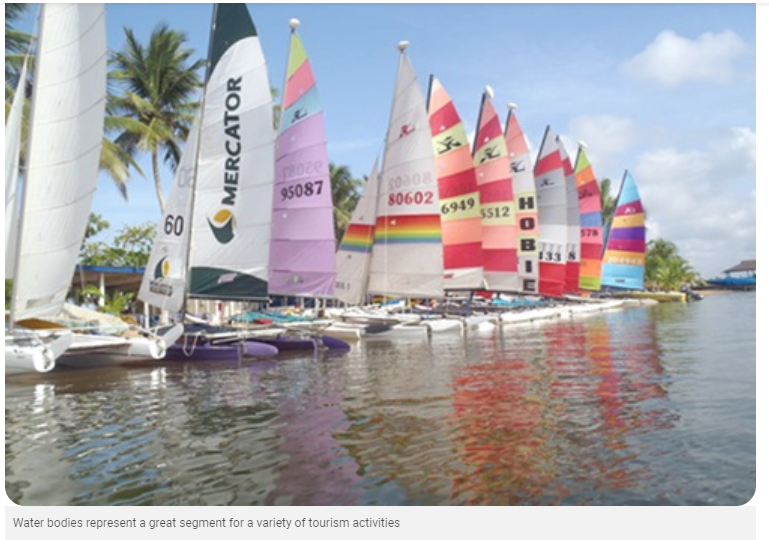In the last half of the 20th Century and the early years of the 21st Century, particularly in Western and industrial nations, there has been a significant growth in the pursuit of water-based experiences as forms of sport, leisure, recreation, and tourism
Water bodies represent a great segment for a variety of tourism activities. Thankfully for us in Ghana, God has blessed us with abundance although in our greed, we are polluting some through galamsey. We have the sea, rivers, estuaries, lakes, lagoons, etc.
This week’s discussion considers the range of water sports that the country can leverage to promote tourism. Already, places such as Ada have sailing clubs with members who engage in race competitions and teaching of beginners.
Having said that let me add that fun as they are, water bodies can also be treacherously dangerous. We all remember what happened to Castro, the musician, and his friend almost a decade ago.
Even for beach areas considered reasonably safe (Keta, Busua and Miamia) it can sometimes become very dangerous and unsuitable, especially for children. With the caution given, let us explore the various water sports activities and how they have fared in recent times.
Boating
As an experience, and as a market, boating can be differentiated by the key energy source for propulsion, that is, whether it is sail driven or motor driven. Both forms continue to be popular in the 21st Century.
Boating, however, is not a singularly focused experience. It usually occurs in association with other water-related activities. This is particularly the case for motorised boating.
Generally, self-contained underwater breathing apparatuses, scuba diving and fishing are the biggest market segments linked to boat-associated activities.
Scuba diving
Scuba diving and the related activity of snorkeling continue to be popular water-based experiences. Free diving is less extensive. In the early 1980s, the sport of scuba diving was projected to grow at a rate of 240,000 per annum.
Within the United States, in the 1990s, it was estimated that there were four to five million participants in scuba as recreation.
Sport fishing and big game fishing
Sport fishing and big game fishing, popular sports of the 1950s and 1960s for those who could afford it, continue to attract a core number of participants, though still only for those who can afford it.
Like most forms of scuba diving (apart from, for example, beach entry dives), sport and big game fishing are reliant on motorised vessels to access key activity sites. Another popular motor-dependent activity is motorised water sports.
Motorised water sports
Motorised water sports, such as jet skiing, wakeboarding, personal hydrofoils and parasailing, have seen participation numbers rise sharply and then plateau in the
twenty-first century as a result of fuel price increases, water resource management controls, and restrictions due to user conflicts associated with perceived losses of amenity and safety issues related to multiple use of sites.
One-day tours
Day tripper numbers in water-related areas—lakes, rivers, canals, coastal zones, and seas—are also growing; for example, on the Great Barrier Reef, approximately 1.5 million visitors take day cruises to access the special features of the reef and the recreation and tourism opportunities available there.
Motorised watercraft are key elements of commercial water-based experiences and enable large numbers of people to experience a wide range of water based environments in a variety of ways.
There are, of course, other activities that are less or not at all dependent on motorised vessels.
Sail training experiences
Sail training experiences enable short-term, medium-length, or long-term participation. Participation may be as a passenger, active participant, or crew member. Passage offerings range from port-to-port or complete voyage (potentially incorporating multiple ports of call).
Sail training is popular with maritime enthusiasts, personal youth development program organisers and participants, business personnel engaged in personal development and team-building exercises, and individuals who have a love of sailing or the sea or seek challenge and adventure.
Surfing, windsurfing, kayaking, and whitewater rafting
Surfing and windsurfing continue to attract large numbers of participants; the same is true, to a lesser degree, for the associated sports of parasurfing and kite surfing.
Additionally, kayaking has grown in popularity as an independent as well as a tourism industry component of water-based experiences. Similarly, white-water rafting demonstrated phenomenal growth in the last four decades of the 20th century.
At the same time, however, both whitewater rafting and kayak-ing participation patterns are constrained by a number of limitations on water resource access.




